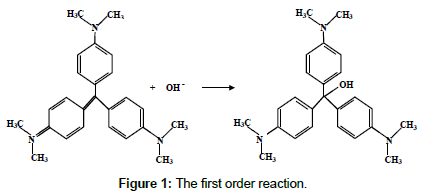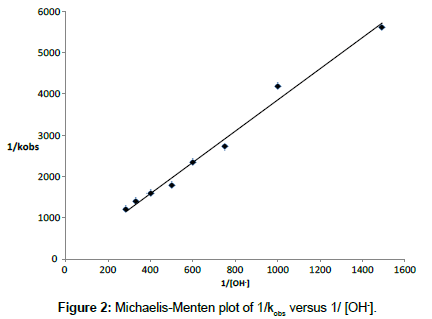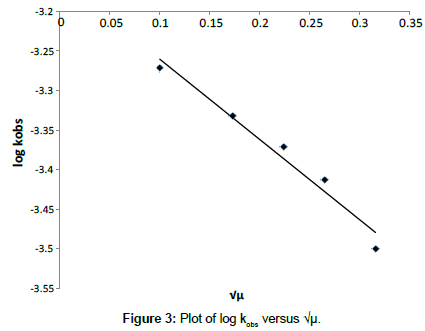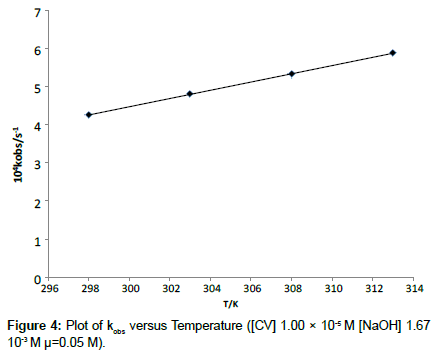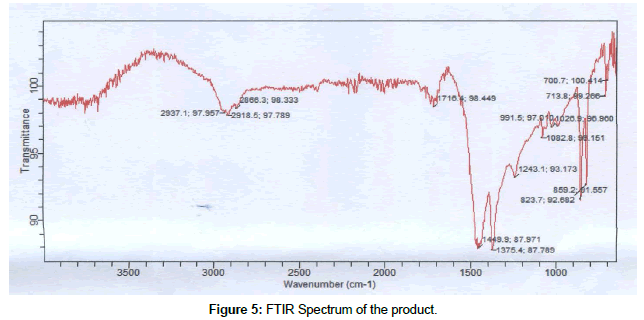Research Article, J Chem Appl Chem Eng Vol: 2 Issue: 1
Kinetic Study of the Discoloration of Crystal Violet Dye in Sodium Hydroxide Medium
Latona Dayo Felix*
Department of Chemical Sciences, Osun State University, PMB 4494 Osogbo, Nigeria
*Corresponding Author : Latona Dayo Felix
Department of Chemical Sciences, Osun State University, PMB 4494 Osogbo, Nigeria
Tel: +2348065248473
E-mail: dayo.latona@uniosun.edu.ng
Received: March 21, 2018 Accepted: April 23, 2018 Published: April 30, 2018
Citation: Felix LD (2018) Kinetic Study of the Discoloration of Crystal Violet Dye in Sodium Hydroxide Medium. J Chem Appl Chem Eng 2:1. doi: 10.4172/2576-3954.1000115
Abstract
The kinetics of the Discoloration of crystal violet in alkaline medium was investigated via pseudo-first order kinetics at λmax587 nm. The reaction was first order dependence on [CV] and [OH-]. A decrease in pseudo first-order rate constant with increase in ionic strength of the reaction mixture was observed. Activation parameters were calculated and a plausible association mechanism in agreement with the kinetic and spectroscopic results was provided. Spectrophotometric titration revealed 1:1 consumption of crystal violet to hydroxyl ion.
Keywords: Crystal violet (CV); Sodium hydroxide; Potassium nitrate; Activation parameters
Introduction
Crystal violet is a cationic triphenyl methane dye which has found great importance in dyeing industries. It is used to dye substrates like cotton, leather and silk [1]. The study of the hydrolysis of crystal violet has not been reported and scanty literature is available on its chemistry. However, hydrolytic reaction of crystal violet in 2-Butoxyethanol and water mixture [2] and the effect of surfactants on alkaline hydrolysis of crystal violet in aqueous solution have been reported [3,4]. Furthermore, the fading of crystal violet in micro emulsions [5] and in 2-butoxyethanol/water mixture have been investigated [6]. Crystal violet like every other triphenylmethane dyes is hazardous to aquatic and terrestrial animals. Crystal violet was reported to be able to induce tumor growth in some species of fish [7]. It has been found to cause reduced RNA and protein synthesis and can cause decreased oxygen consumption in the rabbit granulation tissues [8]. Therefore, due to the hazardous effect of crystal violet, it has become pertinent to find an efficient and less cost effective way of removing it from the environment. Therefore, this research work tends to explore alkaline hydrolytic reaction of the dye with focus on the kinetics of its discoloration in sodium hydroxide medium.
Methods
Experimental
All chemicals used were of analytical grade and solutions were prepared with double distilled water. Crystal violet, sodium hydroxide and potassium nitrate were utilized. Stock solutions of crystal violet, potassium nitrate and sodium hydroxide were prepared and kept in water bath for temperature equilibration. Appropriate quantities in the order of crystal violet, potassium nitrate and sodium hydroxide were measured into a quartz cuvette. All kinetic measurements were carried out with a Simadzu UV-1800 double beam UV-vis spectrophotometer equipped with a thermostat at 587 nm.
Kinetic measurement
The requisite amount of each reactant in the order stated above were introduced into a quartz cuvette and decrease in absorbance of crystal violet with time for each reaction mixture was monitored via pseudo-first order condition. Pseudo-first order rate constants (kobs) were obtained from the slope of plots of InA versus time.



Where, k1=pseudo first order rate constant (s-1)
k2=second order rate constant (M-1s-1)


Stoichiometry
The stoichiometry of the reaction was determined via spectrophotometric titration. The absorbance at infinite time of solutions containing [NaOH]o in the range 6.67 × 10-4–3.50 × 10-3 M, [CV+]=1 × 10-5 M and μ=0.05 M were measured. However, from the plot of Absorbance versus [NaOH] curve, the stoichiometry was determined to be 1:1 (Figure 1).
Results and Discussion
Effect of [CV] on the reaction rate
The reaction was carried out by varying the concentrations of [CV] within the range 1.00 × 10-5 M-7.00 × 10-5 M at 298 K and fixed [NaOH]o=1.67 × 10-3 M and μ=0.085 M (KNO3). The reaction is dependent on the [CV] as observed rate constant (kobs) increases with increase in [CV] as shown in Table 1. The slope of the plot of Inkobsversus In [CV] gave unity, indicating a first order dependence with respect to [CV].
| 105 [CV]/M | 104 kobs/s-1 |
|---|---|
| 1.00 2.00 3.00 4.00 5.00 6.00 7.00 |
1.73 3.22 4.12 5.26 6.10 7.80 8.90 |
Table 1: Effect of [CV].
Effect of [OH-] on the reaction rate
The observed rate constant was determined as a function of hydroxyl ion concentration [OH-] in the range 6.70 × 10-4-3.50 × 10-3 M, keeping all other reactant concentrations constant at [CV]=1.00 × 10-5 M and μ=0.05 M at 298 K. The observed pseudo-first order rate constant increased with increase in [OH-] as shown in Table 2 and showed a first order dependence. The second order rate constant obtained from the slope of a plot of kobs versus [OH-] was 0.25 M-1s-1. The presence of an intermediate complex cannot be over-ruled as a plot of 1/kobs versus 1/[OH-] gave an intercept (Figure 2) [9].
| 103 [OH-]/M | 104 kobs/s-1 |
|---|---|
| 0.67 1.00 1.33 1.67 2.00 2.50 3.00 3.50 |
1.78 2.39 3.68 4.26 5.58 6.28 7.14 8.32 |
Table 2: Effect of [OH-].
Effect of ionic strength on the reaction rate
The dependence of ionic strength on the rate of reaction was monitored by varying the ionic strength of the reaction mixtures within the range 0.01-0.1 M and fixing the initial concentrations of other reactants as [CV] 1.00 × 10-5 M and [OH-] 1.67 × 10-3 M at 298 K. A decrease in kobs with increase in ionic strength of the solution was observed (Table 3). The slope of a plot of log kobs versus √μ gave -1, implying the presence of -1 and +1 charges on the reactants at the rate determining step (Figure 3) [10].
| 102 µ/M | 104 kobs/s-1 |
|---|---|
| 1.00 3.00 5.00 7.00 10.00 |
5.35 4.65 4.26 3.86 2.54 |
Table 3: Effect of Ionic strength.
Effect of temperature on reaction rate
The rate of reaction as a function of temperature was investigated by varying the temperature of the reaction mixtures within the range 298-313K and maintaining constant [CV]o=1.00 × 10-5 M and [OH-]o=1.67 × 10-3 and μ=0.05 M. There was a considerable increase in the observed rate constant (kobs) with increase in temperature (Figure 4). The slope of Arrhenius plot of Inkobs versus 1/T gave activation energy (Ea) of 15.60 kJmol-1. The entropy of activation (ΔS‡) and enthalpy of activation (ΔH‡) and Gibb’s free energy of activation (ΔG‡) were calculated using Erying’s equation as -0.26 kJK-1mol-1, 13.95 kJmol-1 and 91.43 kJmol-1 respectively.
The below listed kinetic and spectroscopic results were the basis for the proposed mechanism:
1. The reaction is first order dependent with respect to [CV] and [OH-].
2. The presence of -1 and +1 charges on the reactants at the rate determining step.
3. The presence of a possible intermediate complex during the course of the reaction.
4. Negative value of ΔS‡, indicating an associative mechanism
5. FTIR product analysis showing the presence of a carbinol with Sharp absorption at 1474.2 cm-1 signals the presence of C=C aromatic ring, the presence of O-H “free” is revealed from the sharp peak at 3650-3600 cm-1. Therefore, carbinol is suggested as the major product of the reaction (Figure 5).


Rate = k2[Complex] (1)
 (2)
(2)
 (3)
(3)
Applying steady state approximation
 (4)
(4)
 (5)
(5)
 (6)
(6)
Substituting equation (6) in (1)


Rate = k[CV + ][OH− ]
Conclusion
Discoloration ofcrystal violet is first order with respect to the concentration of crystal violet and hydroxyl ion concentration. Like all triphenyl methane dyes, discoloration of crystal violet via hydrolysis involves the attack on the carbon within the planar ring of the dye by hydroxyl ion which results to the destruction of the conjugation configuration of the dye thereby yielding carbinol as the reaction product. Hydrolytic reaction of triphenyl methane dyes is most effective and cheapest method of the removal of dyes from industrial effluents.
References
- Wu J, Jung B, Kim K, Lee Y, Sung N (2009) Isolation and characterization of pseudomonas otitidis and its capacity to decolorize triphenylmethane dyes. J Environ Sci (China) 21: 960-964.
- Du Z, Mao S, Chen Z, Shen W (2013) Kinetics of the reaction of crystal violet with hydroxide ion in the critical solution of 2-Butoxyethanol + water. J Phys Chem A 117: 283-290.
- Kabir AR, Susan MB (2008) Kinetics of the alkaline hydrolysis of crystal violet in aqueous solution influenced by anionic surfactants. J Saud Chem Soc 12: 543-554.
- Karayil J, Sreejith L (2017) Catalytic action of CTAB/KBr/C9OH micellar media on the basic hydrolysis of crystal violet. J Dispersion Sci Technol 38: 854-851.
- Chen ZY, Zhao JH, He W, An XQ, Shen WG (2008) Study of association thermodynamic between crystal violet and sodium bis(2-ethylhexyl)-sulfosuccinate and kinetics of basic fading of crystal violet in microemulsions. Inter J Chem Kinet 40: 294-300.
- Cho B, Yang T, Blankenship LR, Moody JD, Churchell M, et al. (2003) Synthesis and Characterization of N-dimethylated Metabolites of Malachite green and Leucomalachite green. Chem Res Toxicol 16: 285-294.
- Mobacken H, Ahonen J, Zederfeldt B (1974) The effect of Cationic triphenylmethane Dye (Crystal violet) on rabbit granulation tissue. Oxygen Consumption and RNA and Protein Synthesis in tissue Slices. Acta Derm Venereol 54: 343-347.
- Goswani G, Kothari S, Benerji KK (2001) Kinetics and mechanism of the oxidation of some diols by benzyltrimethylammoniumtribromide. J Chem Sci 113: 43-54.
- Mohammed Y, Komolafe OA (2010) Investigations into the kinetics and mechanism of Cr (VI) oxidation of hexamethyl pararosalinine chloride in aqueous acid medium. Oriental J Chem 26: 373-377.
- Raj D, Yadav MB, Devra V (2015) Kinetics and mechanistic study of oxidation of serine by Cerium (IV) in presence of Manganese (III) as catalyst in aqueous acid medium. Int J Curr Res Chem Pharm Sci 2: 1-8.
 Spanish
Spanish  Chinese
Chinese  Russian
Russian  German
German  French
French  Japanese
Japanese  Portuguese
Portuguese  Hindi
Hindi 